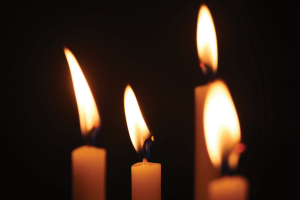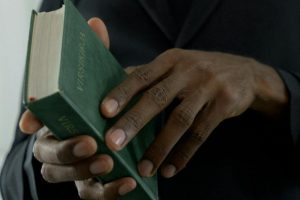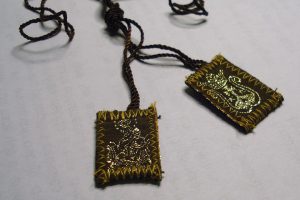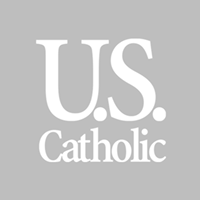How dissenters from Galileo to John Courtney Murray have helped the church to see more clearly.
Dissentt! It is not a nice word. It makes you think of other "dis" words like disagreement, dissension, disobedience, and disgrace. There's no doubt that Catholic Church officials down through the centuries have taken a dim view of dissent, whether it was dissent from official doctrine or dissent from the orders of a legitimately appointed church superior. And, as recent directives from the Vatican indicate, the view is getting dimmer still.
Bring up the subject of dissent at a gathering in your parish, and you may get a fiery reaction: "Dissent? It's terrible, it's a scandal, it tears the church apart! Catholics who dissent ought to have the decency to get out of the church and go somewhere else!"
I've seen that position taken many times in letters to the editor whenever an instance of Catholic dissent hits the newspapers, and I've heard it personally in discussions with serious Catholics. So rather than argue in the abstract about this hot button, it might be helpful to examine dissent in the concrete, as it has occurred down through the centuries of church history.
What we all know is that dissent has at times indeed led to terrible breaks in the Body of Christ through schisms and heresies. What we may not know is that dissent on other occasions-we didn't often hear about these in history class-has helped mightily to clarify doctrine, get the church out of a rut, or bring Christians to a better understanding of themselves and their relation to the world.
Dissenters rarely get a lot of praise in church circles, and sometimes they get thrown out of the community. But the contributions of constructive dissent cannot be ignored or denied.
Almost everyone is aware of the strong dissent Saint Paul expressed toward Saint Peter's position on regulations for Christian converts, as noted in the second chapter of the Epistle to the Galatians. Paul publicly "withstood to his face" this first pope "because he clearly was wrong" (Gal. 2:11), and Peter eventually reversed his position and concurred with Paul in the dispute.
Free at last
To cite a far more recent example of responsible dissent, consider the church's reversal of its time-honored stance on freedom of religion-a reversal that occurred over a 15-year period in the 1950s and 1960s. For the greater part of Christian history, it was accepted as absolute doctrine that civil governments had an obligation to officially recognize the church and support it.
Pope Pius IX made the point in no uncertain terms in 1846 in his encyclical Quanta cura and the accompanying Syllabus of Errors: "The state must recognize [the Catholic Church] as supreme and submit to its influence. . . . The power of the state must be at its disposal and all who do not conform to its requirements must be compelled or punished. . . . Freedom of conscience and cult is madness." Catholics were told that they need not openly oppose a government that did not so recognize the church (as in the United States); rather, they should tolerate the existing situation until such time as Catholics formed a majority of the voting population.
Beginning in 1950 Father John Courtney Murray, a Jesuit theologian, argued that the old tradition must yield. In a series of articles in Theological Studies magazine and in public appearances, he contended that the state should not be the tool of the church and has no business carrying out the church's will. Rather, he said, the civil government's single yet profound obligation is to insure the freedom of all its citizens, especially their religious freedom.
"Every man has a right to religious freedom," he wrote, a right that is based on the dignity of the human person and is therefore to be formally recognized . . . and protected by constitutional law. . . . So great is this dignity that not even God can take it away." Murray claimed the old doctrine as enunciated by Pius IX was not an absolute, static thing but a teaching that had been developing over the past 100 years-a development which Murray saw in the writings of Popes Leo XIII and Pius XII.
The reaction was vehement and instantaneous. The two most influential U.S. Catholic theologians of the day, Fathers Joseph Fenton and Francis Connell, called Murray's argument "destructive, scandalous, and heretical" and engaged in lengthy, published refutations, especially in the American Ecclesiastical Review. Wrote Fenton, "The state is obligated to worship God according to the one religion [God] has established. This is so obviously a part of Catholic doctrine that no theologian has any excuse to call it into question."
Murray did not back down. He continued to develop his dissenting interpretation and respond to his critics' objections. His articles were sent to Rome where they became the subject of considerable concern. In a much-quoted speech in 1952, Cardinal Alberto Ottaviani, the head of the Congregation of the Holy Office, declared (without mentioning Murray by name) that the teaching of Pius IX was as valid now as it ever was, that the state must recognize the church, and that freedom of conscience is an illusion.
Murray was clearly shaken by this clear message to cease and desist. The following year he suffered a heart attack, but after recovery he continued to develop his theory.
By 1954 the Vatican's patience had been exhausted. A Roman censor forbade the publication of an article that Murray had written and considered crucial to his case. Murray's Jesuit superior ordered him to cease writing on the subject. When Murray inquired what he could write about, the superior said he might consider poetry.
During the next four, difficult years Murray did not wear the gag lightly. According to his biographer Donald Pilotte, he attempted to have the banned article published anonymously. But the attempt was unsuccessful, as were several other efforts to keep the debate alive. So for a time he wrote on related but less sensitive matters.
In 1958, when a new pope, John XXIII, was elected, Murray emerged from the closet. He pulled together the thrust of his arguments into a popular book titled We Hold These Truths, whose publication just happened to coincide with the presidential campaign of John F. Kennedy. Public worries in the United States about what Kennedy, a Catholic, might do in office were greatly dispelled by Murray's well-argued contention that religious freedom and separation of church and state were not mere tactics of toleration but valid expressions of a developed Catholic doctrine.
Murray and his book made the cover of Time magazine, and the Kennedy campaign relied on him for counsel concerning touchy church-state issues. Some historians contend that it was not Mayor Richard J. Daley's delivery of the Chicago vote that got Kennedy elected but John Courtney Murray.
Still, top Catholic theologians and Roman officials regarded him as a dangerous dissident. When plans were underway for the Second Vatican Council in 1962, Murray was expressly "disinvited" to join the commission of experts, headed by Ottaviani and including Fenton, that was preparing a statement on human freedom. Although he was experiencing chronic heart problems, Murray would not accept the snub. He wrote to the American bishops on the commission, urging them to fight against any rubber stamp of the outmoded Pius IX doctrine. He was, in fact, so persistent that the U.S. bishops finally asked him to assist the commission in Rome.
Armed with all his scholarship, he publicly debated the issues with Fenton and Ottaviani and became a major drafter of the council's Declaration on Human Freedom. In its final form, approved in a vote by the world's bishops, 2,308 to 80, in 1965, the declaration said, "This synod declares that the human person has a right to religious freedom. This freedom means that all men are to be immune from coercion on the part of individuals, social groups, or any human power . . . This synod further declares that the right to religious freedom has its foundation in the very dignity of the human person, as this dignity is known through the revealed word of God and reason itself." The words reflect Murray's thinking and may very well have been written by him.
He lived only 18 months after that vote, succumbing in 1967 to another heart attack at the age of 62, but his legacy is profound. His friend, Jesuit Father Walter Burghardt, noted on the occasion of his death, "Unborn millions will never know how much their freedom is tied to this man whose pen was a powerful protest, a dramatic march against injustice and inequality, whose research sparked and terminated in the ringing affirmation of an ecumenical council: The right to religious freedom has its foundation not in the church, not in society or state, not even in objective truth, but in the dignity of the human person."
That John Courtney Murray was a dissident is undeniable. That his prolonged dissent was vindicated by the church at its highest level is equally undeniable.
Although the Murray experience is dramatic, it is not essentially different from the experiences of other scholars who have questioned the absolute nature of some church teaching. Theologians like Jean Danilou, Yves Congar, Karl Rahner, and Henri de Lubac all lived parts of their lives under dark shadows of suspicion and accusation.
Sensible faithful
Even John Henry Newman, often cited as the greatest Catholic figure of the 19th century, took a significant dissenting stance and suffered the consequences. Ironically, this dispute was over an occasion of dissent by hundreds of thousands of Christians that occurred 1,400 years before Newman was born.
In 1859 Newman was 59 and past his prime physically though not intellectually. As the editor of the magazine Ramparts, he got into trouble with the English hierarchy for asserting in an article that the British bishops would be well-advised to seek the counsel of lay Catholics in important matters. Such a view was regarded as rash and disruptive of good order. He was subsequently informed by his own bishop that the next issue of Ramparts, July 1859, would be his last as editor.
Newman accepted the decision somewhat badly, then set to work producing an exceptionally long study that constituted the entire July issue. It was titled "Consulting the Faithful on Matters of Doctrine," and it set off a firestorm of controversy because Newman placed himself in bold opposition to well-established teaching and interpretation.
In his study, Newman returned to a subject on which he was unquestionably the world's leading authority: the fourth-century Arian heresy (a movement that claimed that Jesus is not God, only God's greatest creation). Newman reviewed exhaustively a 60-year period that followed the Council of Nicaea in 325; the council had condemned Arianism and formulated in the famed Nicene Creed the orthodox position. However, during that post-conciliar period, Newman showed, the overwhelming number of bishops and dozens of regional church councils dismissed the Nicene formula and embraced Arianism. Even Pope Liberius signed a pro-Arian statement, though probably under pressure.
So great and so widespread was the Arian position, said Newman, that it would surely have become official Catholic doctrine, except for one thing: the Catholic laity. In Europe, Asia, and the Middle East they dissented from what their priests, their bishops, even their pope was proposing. Jesus is true God, they insisted in the face of excommunication, persecution, and (in some cases) martyrdom.
As it turned out, they won. At the First Council of Constantinople in 381, the Arian heresy was finally laid to rest, and the hierarchy agreed to abide by the faith of the people. Summarizing this remarkable period, Newman wrote, "The Nicene dogma was maintained during the greater part of the fourth century not by the unswerving firmness of the Holy See or councils of bishops but by the consensus of the fidelium [the faithful].
"On the other hand, I say that there was a temporary suspension of the functions of the ecclesia docens [teaching church]. The body of the bishops failed in their confession of the faith. They spoke variously against one another. There was nothing after Nicaea of firm, consistent testimony for 60 years. There were untrustworthy councils, unfaithful bishops . . . misguidance, delusion, hallucination . . . extending itself into nearly every corner of the Catholic Church."
From all this Newman drew some shocking conclusions that have been reverberating in the church ever since: that there is in the body of the faithful (the laity) an "instinct" for the truth, that this "sense of the faithful" must never be ignored or taken for granted by the church's official teachers, that authentic church teaching therefore comes about through a kind of "conspiracy" or cooperative enterprise on the part of both laity and hierarchy, and finally that certain lapses (or "suspensions") can occur when one side or the other of this living body temporarily ceases to function.
This was radical interpretation indeed, and there was immediate protest. Was Newman actually saying that the infallibility of the church doesn't reside exclusively in the church's head? asked the prominent English theologian John Gillow. Newman replied that he meant what he said: Because the promise of the Holy Spirit was given to the whole church, the whole church must be a party to its decisions.
This seemingly unprecedented elevation of the laity was particularly abhorrent to Msgr. Edward Talbot, a leading churchman, who asked in exasperation, "What is the province of the laity? To hunt, to shoot, to entertain. These matters they understand, but to meddle with ecclesiastical matters they have no right at all. . . . Dr. Newman is the most dangerous man in England."
Newman would not recant; thus charges were brought against him before the Vatican's Office of Propaganda by several English bishops, and a protracted investigation got underway. For the next six years Newman lived under a cloud, his creativity seriously impeded.
"This age of the church is peculiar," he complained. "In former times primitive or medieval, there was not the extreme centralization now in use . . . There was true private judgment in the primitive and medieval schools. . . . There are no schools now, no freedom . . . of opinion, no exercise of the intellect."
A decisive resolution never came from Rome, the affair passed, and in his last days Newman was made a cardinal for his lifetime contributions to the church.
Following his death in 1890, theologians began to further develop his concept of the church as an organism of interactive parts. That theology is still in process, but it achieved a measure of official recognition at Vatican II, which Pope Paul VI called "Newman's council." Said the Dogmatic Constitution on the Church, "The body of the faithful as a whole, anointed as they are by the Holy One, cannot err in matters of belief . . . thanks to a supernatural sense of faith which characterizes the people as a whole. . . ."
And in another place the constitution declared, "Christ, the great prophet . . . continually fulfills his prophetic office . . . not only through the hierarchy who teach in his name . . . but also through the laity."
A woman who did much
One should not conclude from these two examples that responsible dissent is necessarily restricted to highly educated male clerics. Women too have dared to dissent; one notable example is Mary Ward, the foundress in the 17th century of a women's religious order called the Institute of the Blessed Virgin Mary (IBVM).
She was born into a well-established English family that persevered in the Roman Catholic faith after Anglicanism became Britain's official church. Because religious orders were banned in England at the time, Ward went to the Netherlands at the age of 20 and entered a convent of the Poor Clares.
Quickly discerning that the monastic life was not for her and sensing that she was called by God to "some other thing," she left the Poor Clares and returned to England. She had made the Spiritual Exercises of Saint Ignatius while in the convent, and she gradually developed the idea of a religious order of women modeled on Jesuit spirituality and combining contemplation with good works in the world, especially through the religious education of women.
Her institute, as she conceived it, would have no requirement of enclosure or cloister, would be governed entirely by women, and its members would wear secular clothes instead of a distinctive habit.
This vision was in direct conflict with the church's clearly enunciated regulations for women religious at the time, and Mary Ward knew it. The Council of Trent, which concluded just 21 years before Mary Ward was born, ordered bishops "by God's judgment" and under threat of "eternal malediction" to require strict enclosure in all religious houses under their jurisdiction. It was ruled "unlawful for any nun to go out of her convent even for a brief period under any pretext whatever" unless she had express permission from her bishop.
The juridic status of women in that era, noted historian James Cain, was "one of complete subjection to the dominion of man, having no authority of her own." A contemporary directory of spiritual formation declared that women have little potential for development "unless one or another among them should have the capacity for spiritual things."
Ward did not agree. She ardently believed that the active and contemplative styles of life were compatible for women as well as men, and after considerable discernment and prayer felt a "solid contentment" in her stance.
Accompanied by a growing number of followers, she began to establish schools and foundations. In 1624 she submitted her plan to Pope Urban VIII for official approval. He replied by closing the IBVM foundation in Rome but took no further action for seven years. Undeterred, the institute spread its activities into France, Germany, Holland, Italy, Austria, and even England, where the absence of distinctive nuns' garb allowed the members to serve the Catholic population without arousing governmental opposition.
But the institute did arouse opposition and complaint from other quarters. Many priests resented these bold, upstart women and their obviously dissident lifestyle, and the Jesuit general prohibited his members from giving Ward and her followers any assistance.
The ax fell in 1631. In a bull of suppression the pope disbanded the IBVMs, dissolved the vows of the members, and forbade the recruiting of any new members. Mary Ward was imprisoned for two months in Munich as a "heretic, schismatic, and rebel against holy church." Although those personal charges were quickly dropped, the provisions of the bull remained in effect. It described unenclosed religious communities as "pernicious growths" and dismissed the IBVM educational ministries, claiming women "are incapable of the knowledge necessary for teaching scripture."
Ward endured all this with admirable equanimity. She urged her members not to despair and spent most of the remaining 14 years of her life in England working as a laywoman with Catholic students. Late in life she said, "I hope in God that it will be seen in time that women . . . will do much."
After her death, the institute survived as a small, unenclosed, and unapproved group of women for 58 years, until its regulations were approved by Rome in 1703. Thereafter it spread throughout the world as an institute of religious women. It continues still. Yet only in 1909 (269 years after Mary Ward's death) were IBVM members permitted to acknowledge Ward as their founder.
Today Ward is widely celebrated as a pioneer well ahead of her time who recognized the capacity of women for active lives in Christian ministry. In 1951 Pope Pius XII honored her as "that incomparable woman given by Catholic England in the darkest of periods."
And still it moves
A close scrutiny of history will show that Mary Ward is among a veritable cloud of women who have taken issue with the church teaching or regulations over the centuries. Their numbers include saints like Catherine of Siena, Teresa of Avila, Bridget of Sweden, and Hildegard of Bingen-all remembered for their faithfulness to the gospel as they understood the message in their time. They join a cast of men who creatively protested in various eras (see above).
If responsible male dissidents are cited more often in history, it is because-as priests, bishops, theologians, or persons of great learning-they were more often in positions where their dissent got noticed and made an immediate impact.
Perhaps the best known responsible dissident of Catholic history is the 17th-century astronomer Galileo Galilei. As the first man to study the skies with a telescope, Galileo attempted to disprove the firmly accepted Ptomelaic doctrine that the earth stands still at the center of the universe while the sun and other heavenly bodies circle around it every 24 hours.
In defending his adherence to the Copernican theory (that the earth and other planets revolve around the sun), Galileo suggested that perhaps the church had been accepting the words of scripture too literally for too long. He tried to show that a tradition of the church, even a long-standing one, might not be valid if it had always been taken for granted as true and never really scrutinized.
Accused of heresy and confronted with the instruments of torture, Galileo recanted in 1633. The pope who prosecuted Galileo, Urban VIII, was, incidentally, the same who suppressed Mary Ward's institute.
Only in 1992, 350 years after Galileo's death, did another pope, John Paul II, apologize for the church's shortsighted treatment of the great scientist.
It would be, of course, rash to conclude from this brief overview that dissent is always and everywhere a legitimate option. Catholics believe the teachings of the pope and the bishops are not just opinions to be lightly regarded or disregarded. Belief in the teaching authority of the church is a part of the faith, and authority is generally to be given the benefit of the doubt. An argumentative and contentious attitude is not conducive to the spirit of unity that ought to mark the People of God.
On the other hand, history demonstrates that some teachings, even some that appeared to be solidly entrenched in scripture and tradition and taught at the highest levels, were not as well-grounded as the magisterium at the time believed them to be. This is what the past reports back to us in myriad ways. No one can live in a hermetically sealed box oblivious to the experience of the Body of Christ as it has been lived; historical unconsciousness is not an option.
All are called to wrestle with the facts and their implications for difficult matters in our own time. At the very least, history should stimulate a bit of humility-making the church at every level less prone to pontificate despite natural inclinations to do so. The church moves and grows and learns through the ages-and the Spirit blows where it will.
This article appeared in the May 1999 issue of U.S. Catholic (pages 12-17).














Add comment